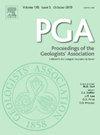来自萨默塞特郡霍维尔的雷蒂亚海王星堤防的微型脊椎动物:裂缝的年代测定
IF 1.2
4区 地球科学
Q2 Earth and Planetary Sciences
引用次数: 0
摘要
布里斯托尔和南威尔士附近中生代裂缝沉积物的年代测定一直是个问题,更古老的例子的年龄有争议,是卡尼宙还是雷蒂亚宙,两者相差3000万年。萨默塞特郡霍尔韦尔(Holwell)充填裂缝的沉积物提供了一个确定至少一个裂缝系统的日期的机会,因为它们位于门迪普古岛(Mendip palaeisland)的海岸,靠近层状的雷蒂亚(Rhaetian)海相沉积物。自19世纪50年代以来,Holwell裂缝就被人们所知,当时他们发现了一些有史以来第一批中生代哺乳动物,它们是几种鲨鱼化石的典型地点,Duffinselache holwellensis, pseudoetorhinus pickfordi和Palaeobates reticulatus。在Holwell的一个neptune堤防中发现了3000多个可识别的标本,其中主要包括海洋鱼类,但也包括生活在古岛上的沿海齿形动物和陆地衍生的鳞片龙。超过95% %的动物群包括四个鱼类分类群,是典型的层状韦斯特伯里组。较少见的Rhomphaiodon minor与丰富的Synechodus rhaeticus相结合,表明该矿床可能不是基底,而是在Westbury组的上半部分。我们在此确认这些霍维尔裂缝填充动物,包括哺乳动物,都是雷蒂亚时代的。本文章由计算机程序翻译,如有差异,请以英文原文为准。
Microvertebrates from a Rhaetian neptunian dyke at Holwell, Somerset: Dating the fissures
Dating the Mesozoic-aged fissure deposits around Bristol and South Wales has been problematic, with ages of the older examples disputed as either Carnian or Rhaetian, a 30-million-year difference. The deposits filling fissures at Holwell, Somerset offer a chance to establish a date for at least one system of fissures because they are on the coast of the Mendip Palaeoisland, close to bedded Rhaetian marine deposits. The Holwell fissures have been known since the 1850s when they yielded some of the first ever reported Mesozoic mammals, and they are the type locality for several fossil shark species, Duffinselache holwellensis, Pseudocetorhinus pickfordi and Palaeobates reticulatus. Bone-rich fissure fills from a neptunian dyke at Holwell yielded over 3000 identifiable specimens, comprising mainly marine fishes but also coastal-dwelling placodonts and terrestrially derived lepidosaurs that lived on the palaeoisland. Over 95 % of the fauna comprises four fish taxa that are typical of the bedded Westbury Formation. The less common Rhomphaiodon minor associated with abundant Synechodus rhaeticus indicates that the deposits are likely not basal but are within the upper half of the Westbury Formation. We hereby confirm that these Holwell fissure fill faunas, including the mammals, are of Rhaetian age.
求助全文
通过发布文献求助,成功后即可免费获取论文全文。
去求助
来源期刊
CiteScore
2.70
自引率
8.30%
发文量
54
审稿时长
6-12 weeks
期刊介绍:
The Proceedings of the Geologists'' Association is an international geoscience journal that was founded in 1859 and publishes research and review papers on all aspects of Earth Science. In particular, papers will focus on the geology of northwestern Europe and the Mediterranean, including both the onshore and offshore record. Following a long tradition, the PGA will focus on: i) a range of article types (see below) on topics of wide relevance to Earth Sciences ii) papers on aspects of Earth Science that have societal relevance including geoconservation and Earth management, iii) papers on palaeoenvironments and palaeontology of the Mesozoic and Cenozoic, iv) papers on aspects of Quaternary geology and climate change, and v) papers on the history of geology with particular reference to individuals that have shaped the subject. These topics will also steer the content of the themes of the Special Issues that are published in the PGA.

 求助内容:
求助内容: 应助结果提醒方式:
应助结果提醒方式:


